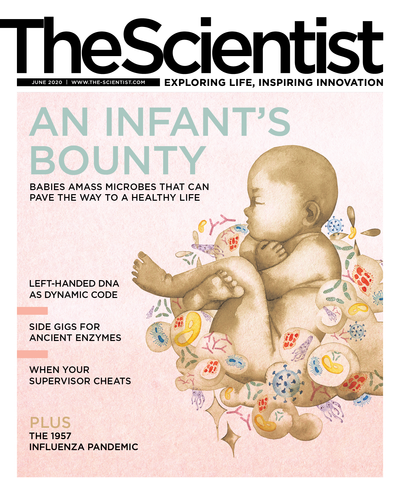Features

Protein Synthesis Enzymes Have Evolved Additional Jobs
Amber Dance | Jun 1, 2020 | 10+ min read
Aminoacyl-tRNA synthetases, which help translate the genetic code into protein, also function in angiogenesis, fat metabolism, and more.

Left-Handed DNA Has a Biological Role Within a Dynamic Genetic Code
Rachel Brazil | Jun 1, 2020 | 10+ min read
Once considered an unimportant curiosity, Z-DNA is now recognized to provide an on-the-fly mechanism to regulate how an RNA transcript is edited.

The Infant Gut Microbiome and Probiotics that Work
Jennifer T. Smilowitz and Diana Hazard Taft | Jun 1, 2020 | 10+ min read
The gut microbiome is more malleable in the first two years after birth, allowing probiotics to make their mark. Can we exploit this to improve infants’ health?
Contributors
Contributors
Contributors
Meet some of the people featured in the June 2020 issue of The Scientist.
Editorial
Armchair Virologists
Armchair Virologists
Pretending to be a javelin aficionado is one thing. Professing to have real insight into the ongoing pandemic is quite another.
Speaking of Science
Ten Minute Sabbatical
Ten Minute Sabbatical
Take a break from the bench to puzzle and peruse.
Notebook
Did Contaminated Water Exacerbate Brazilian Babies’ Zika Symptoms?
Did Contaminated Water Exacerbate Brazilian Babies’ Zika Symptoms?
Elevated levels of a neurotoxin in northeastern Brazil’s drinking water and a high incidence of microcephaly in the region led scientists to look for a link, and they found one.
How Squirrels Use Bird Chatter to Assess Safety
How Squirrels Use Bird Chatter to Assess Safety
An undergraduate research project finds the animals are tuned in to reassuring information from other species.
The Hidden World of Millipede Sex
The Hidden World of Millipede Sex
Researchers use advanced imaging techniques to see what happens when a male and a female mate.
A Citizen Scientist Makes Her Mark in Microbiome Research
A Citizen Scientist Makes Her Mark in Microbiome Research
The BioCollective, a company that transforms whole stool samples into microbial metadata, is developing the US’s first national microbiome reference material.
Modus Operandi
Vaccines Without Vials, Fridges, or Needles
Vaccines Without Vials, Fridges, or Needles
A novel preparation technique could facilitate vaccine preservation, transportation, and administration.
The Literature
Host Cells Release Exosomes to Sop Up Bacterial Toxins
Host Cells Release Exosomes to Sop Up Bacterial Toxins
During bacterial infection, autophagy proteins appear to regulate the release of cell-saving exosomes, which bear the brunt of toxin damage.
Gut Microbiome Composition Linked to Human Behavior
Gut Microbiome Composition Linked to Human Behavior
A study uncovers connections between the bacteria in our guts and our social lives.
How a Pea Aphid Decides to Make Wings or Not
How a Pea Aphid Decides to Make Wings or Not
Wing development in females is environmentally controlled, but in males, an insertion on the sex chromosome appears to dictate whether the insects grow wings, according to a study.
Profiles
The Father of Autoimmunity: A Profile of Noel Rose
The Father of Autoimmunity: A Profile of Noel Rose
By revealing that animals could develop immune responses against their own tissues, the physician-scientist established an entirely new field of science.
Scientist To Watch
Janelle Ayres Explores the Ways in Which Animals Tolerate Disease
Janelle Ayres Explores the Ways in Which Animals Tolerate Disease
The Salk Institute researcher was one of the first to show that killing a pathogen isn’t the only way to survive an infection.
Careers
When Your Supervisor Is Accused of Research Misconduct
When Your Supervisor Is Accused of Research Misconduct
Early career researchers face unique challenges when a senior collaborator becomes embroiled in allegations of scientific malpractice.
Reading Frames
Revolutionary Repurposing
Revolutionary Repurposing
Evolution needn’t make improbable leaps to facilitate transitions into uncharted biological territory. Adapting new uses for existing structures works just fine.
Foundations
Confronting a Pandemic, 1957
Confronting a Pandemic, 1957
Microbiologist Maurice Hilleman foresaw the global spread of a novel influenza strain in 1957. His vaccine saved hundreds of thousands of lives.
Infographics
Infographic: Synthetases and the Evolution of Circulatory Systems
Infographic: Synthetases and the Evolution of Circulatory Systems
Aminoacyl tRNA synthetases picked up new protein domains that participate in vasculature formation around the same time that organisms evolved key adaptations in the circulatory system.
Infographic: DNA Isn’t Always Right-Handed
Infographic: DNA Isn’t Always Right-Handed
When the nucleic acid spirals to the left, it takes on a zig-zag shape known as Z-DNA that appears to regulate RNA editing.
Infographic: The Changing Infant Gut Microbiome
Infographic: The Changing Infant Gut Microbiome
The microbial makeup of a newborn baby’s intestines has changed dramatically over the past 100 years, and we are now beginning to understand how and why this matters.
Infographic: How Cells Use Decoys to Defend Against Pathogens
Infographic: How Cells Use Decoys to Defend Against Pathogens
Specialized exosomes sop up bacterial toxins, a study finds.
Infographic: Vaccines on Film
Infographic: Vaccines on Film
How an experimental preparation technique could make vaccines easier to transport, store, and administer





















